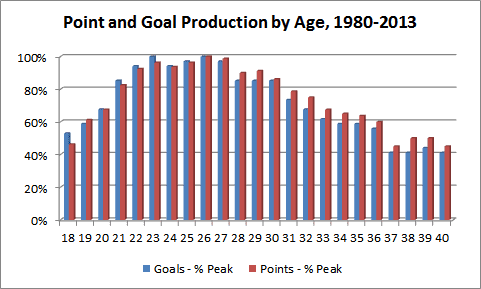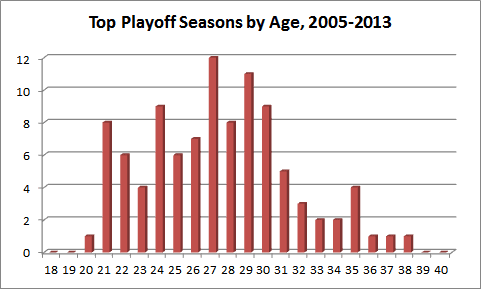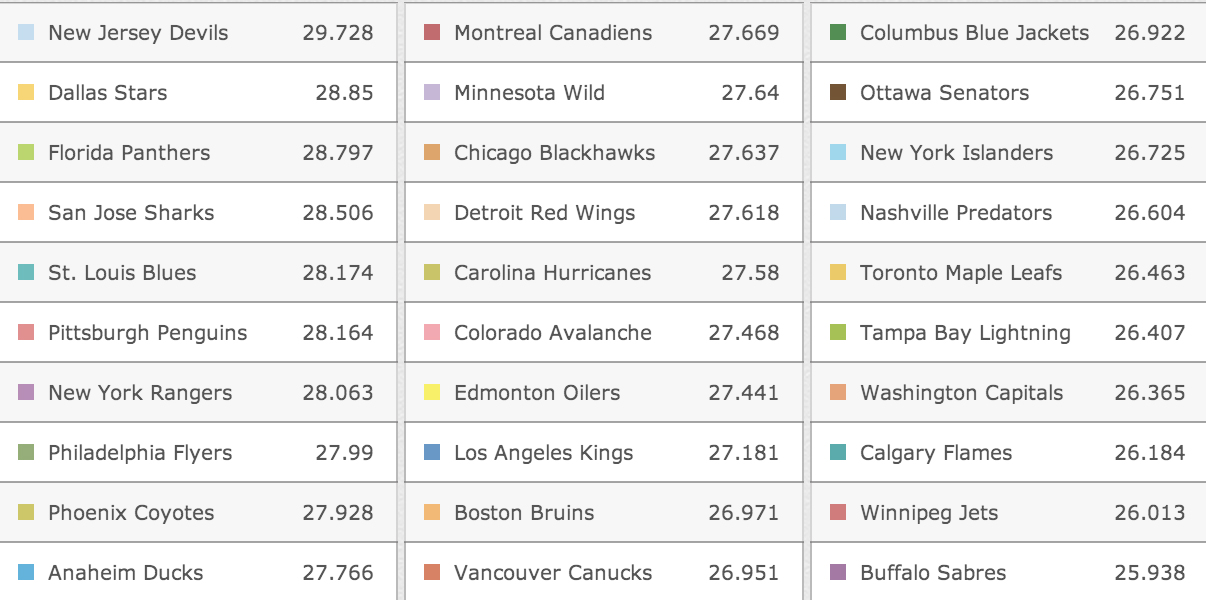Why the Detroit Red Wings were always going to struggle to go deep
Few players in the history of the National Hockey League have been able to avoid the inevitable production curve that comes with age. Young players come to the league, improve for a couple years, level out for a few more, then go into decline. That’s your standard career.
A cursory glance at production by age (found here) amongst the NHL’s top-100 point producing players each year from 1980 to 2013 looks like this:

You can see that success maxes out according to this graph at age 26. As for the top playoff performers over the past eight seasons:

Not the hugest sample size, but those graphs are just to illustrate my point: players play their best around a certain mid-20s age. That’s an undeniable truth.
Because of that I’ve found myself becoming a bit of an ageist, and more to the same point, a seasonist (no YOU’RE making words up).
I believe that teams have the most success when their best players are in their prime producing years, and in the case of true superstars (think Patrick Kane and Jonathan Toews), that’s a lot younger than most people think. Incidentally, that’s why I say seasonist, not just ageist - true stars who've been in the league for four seasons at 22 are different from 24-year-old rookies.
All this brings me to the Detroit Red Wings. Watching them this post-season, I can’t help but feel like they have a terrific roster with messed up ages. If their young guys were older and their old guys younger, they might be Cup contenders. But as it goes in hockey, timing is everything, and this year it isn’t on their side.
The Red Wings and Bruins both show up on quanthockey.com as “average aged teams,” as you can see below. They’re both in the middle third there.

But that doesn’t exactly tell the story. While the majority of the Bruins best offensive players are in their output primes -- Patrice Bergeron (28), Milan Lucic (25), Brad Marchand (25), David Krejci (27), Loui Eriksson (28) -- the Red Wings miss on both sides.
I’m looking strictly at forwards because I believe scoring goals is the hardest thing to do in the playoffs when everyone doubles down on defensive responsibility, and it’s part of the reason the Red Wings won’t be able to upset Boston.
Here’s the Red Wings group:
Ages 24 & under - on the come-up
Five young players who’ve all seen consistent ice in the post-season. Not the youngest, but as inexperienced as you can get.
Tomas Tatar (23, first full season)
Riley Sheahan (22, rookie)
Gustav Nyquist (24, first full season)
Tomas Jurco (21, rookie)
Luke Glendening (24, rookie)
Between 25 and 29 years old - prime time
Three players, none of which have averaged above 16 minutes of ice in the post-season. Joakin Andersson has dressed once in the post-season.
Darren Helm (27, above-average player)
Justin Abdelkader ( 27, good role player)
Joakin Andersson (25, generally not that effective)
Not exactly Anze Kopitar, Mike Richards, Jeff Carter, Dustin Brown, is it?
30-plus - in decline
Ten players, including the bulk of the minutes-eaters (Datsyuk, Zetterberg, Franzen)
Daniel Alfredsson (41)
Todd Bertuzzi (39)
Daniel Cleary (35)
Drew Miller (30)
Pavel Datsyuk (35)
Johan Franzen (34)
David Legwand (33)
Mikael Samuelsson (37)
Stephen Weiss (31)
Henrik Zetterberg (33)
After the Wings dropped Game 3 at the Joe to go down 2-1 in the series, Mike Babcock made the comment “I thought we looked like kids tonight for sure, no question about it.” Ray Ferraro elaborated on that on-air saying “The kids looked like kids, and everyone else looked like old men.”
In today’s salary cap NHL, you almost have to have kids contributing on their entry-level contracts. Those deals are so financially limited that it frees you up to pay big guns in their prime years while staying under the cap. The kids gain experience, and everything they can give you is basically gravy. It makes sense to have them.
But when they’re still in the "getting their feet wet" stage, and the rest of your group is past their primes, you’re going to struggle to contend with the best.
In 15 years you might look back at the current group of forwards the Red Wings have and think “Damn, that roster lost in the first round?” They’ve got a number of players who’ve had good careers, and have a few more that looked poised to do the same. But when you’re only catching the peak years of two of your forwards, winning a Cup, or even a playoff round, is a pretty sizeable mountain.